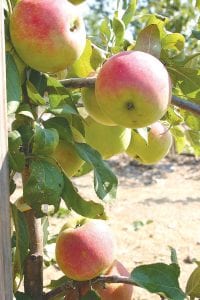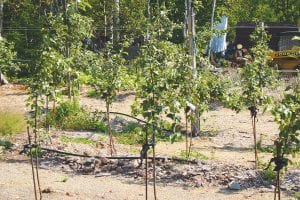Although his oldest apple tree is two years old, Ray Block has already raised trees that have produced some beautiful apples, as pictured on the left. Block experiments with bagging apples. The bags help the apples ripen faster and protect them from bugs and birds. Block’s orchard on the north shore of Lake Superior has 60 apple trees and 20 rootstalks. Next year he expects to plant another 110 apple trees.

Ray Block believes someone could make money raising apples in Cook County. Block also believes his irrigated apple orchard could provide a fire block against wildfires and help provide better nutrition to local school kids and the elderly.
If his dreams become a reality, Block might become the Johnny Appleseed of Northern Minnesota.
“I’m using a system called the tall spindle system. Trees grow to be about 10 feet tall and can be spaced closely. They produce a far higher yield than older apple orchards and are easier to manage,” Block said.
Located about two miles west of Grand Marais below Highway 61, Block began planting on the thin soil about 100 yards from Lake Superior two years ago and now has 60 apple trees and 20 root stalks. One of his trees currently has 60 apples and while some of the newer trees haven’t produced yet, Block isn’t deterred.
“This is fun for me. I like to come out here when the sun comes up with a cup of coffee and check the trees. Look for insects. Look for the good and the bad and try to learn something new every day,” he said.
Cedar mulch is spread between the trees, around the roots and down the rows. The mulch, which he got for free, helps to insulate the trees in the winter and keeps the weeds off in the summer.
Some of the apples have clear plastic bags around them, some don’t. This is another experiment.
“Last year I bought three apples from the grocery store, a HoneyCrisp, a McIntosh and a Gala. I had my nieces try those and then try the same varieties from my garden. They liked mine best. Especially the ones bagged. They are sweeter—the apples produce more sugar when they are bagged. The apples also ripen faster and the bags keep the birds and insects off.”
Trees are trellised and wired in place to protect against wind damage. Most of the materials for this were also found or donated by friends. Friends who will get paid in apples, said Block with a grin.
Instead of using pesticides, Block sprays an organic product that is called Surround.
“It’s an organic clay that aggravates the bugs. They don’t like it and they stay off the apples. It’s not a poison.”
Each row has a different story. Block plants different root stalks, different varieties of trees, puts clear plastic bags on some apples, which he dates, and not on other apples right next to the bagged ones.
“I’m trying to figure out the best time to bag the apples. Right now it looks like July 4th is the right time to bag them. But we’ll see. I’ll keep experimenting until I get it right.
“I fail sometimes. But I guess I learn as I go. I am after growing the perfect apple. That’s what I’m trying to do here.” Block said.
He calls the gate outside of the orchard, “My Jurassic Park look.” He got the wood and fencing for free, sometimes salvaging from the recycle pile.
“A guy gave me the irrigation tubing. Said he wasn’t going to use it, so he gave it to me.”
Block said irrigation water for the orchard comes from an artesian well down the road, which also costs nothing.
To protect the apples from the many apple-loving predators in the area, Block has installed an elaborate fence.
It starts with a wire fence, which is about six feet tall and bent inward. “That’s because the deer try to judge a fence they want to jump over. The angling of the fence gives the fence more of an intimidating perspective and they usually won’t try to scale it,” he said.
Atop the metal fence is an electric fence. Down low there is a rabbit fence and below that there are ground wires for mice. There is also a metal pipe about two feet off the ground for bears. “When they put their paws on the tube they also come in contact with a ground wire and get a nasty shock,” said Block.
Another trick to keep the deer away is to wrap some apple bits in aluminum foil and attach it to the electric fence. When the deer lick the foil, they get a little zap. “It’s supposed to make them never want to eat apples again. But I don’t know if that’s true or not,” Block said with a smile.
When asked if he has a favorite apple, Block replied without hesitation, “Honeycrisp. It’s the best eating apple in the world. It will be in season here in October and it is the longest storing apple. I will be able to eat fresh apples all winter long. That and apple pie.”
Because Honeycrisp apples won’t be ripe until October, Block said he believes they will be the latest Honeycrisp crop harvested in the U.S.
Which, he said, should make them more valuable on the market.
Not that Block is after a profit right now. “I would like to break even eventually. But for now I would like to donate some apples to the school or the Senior Center or nursing home.”
While Block is concentrating on growing Honeycrisp apples, he is also experimenting with other varieties like Sweet 16s, Firesides and Kerr Crabapples.
He has ordered 110 apple trees for next spring. He plans to plant westward down the gravel road on family-owned property.
“Originally I wanted to do something that would protect the property from wildfires. I looked at the Firewise information and saw that, say if you put in a sprinkler system it had to be checked every two weeks. You would do that and have nothing to show for your labor. With this, the irrigation system for the apple trees and the clearing of land for the orchards will protect against fire and I will have something to show for my time. It’s also become a hobby I enjoy very much.”
Someday Block hopes to raise enough apples so he can “drive the price of apples down locally so a kid can afford to buy one. I’ve paid as much as $3 for a Honeycrisp apple. That’s too much. It would be nice to sell them for a quarter, maybe 50 cents.”
Block said he would also like to work with other apple growers in the area and form a co-op of sorts. “We could help each other and exchange information about what soils work best, what pests they are dealing with and how to stop them. Just bounce ideas off of each other and learn from each other.”
As far as making money, Block was honest in his assessment. “Last I heard there has never been a profitable organic apple farm in Minnesota. But from what I’ve seen, from my experience so far, I don’t know how you couldn’t make a profit if you really wanted to.”




Loading Comments